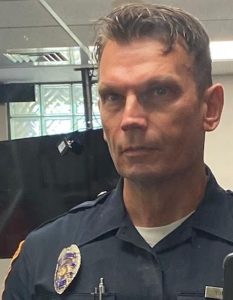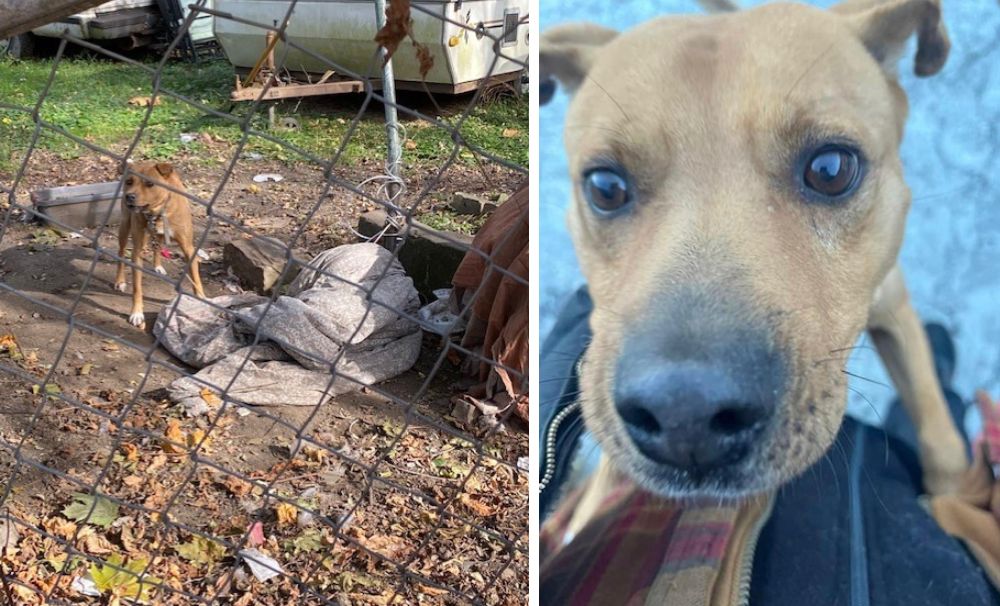When Campbell Police Officer Jim Conroy heard incessant barking one day while on his rounds, he decided to investigate — knowing in his gut and from years of law enforcement experience that there was “something more to it.”
In a backyard he found Carmelo — a dog without access to food or shelter and filthy water — whom he would later learn had spent eight years tethered by a 2-foot chain.
Conroy spoke with Carmelo’s owner, who surrendered the suffering dog. Carmelo now is recuperating because of that compassionate action, but he is just one of the dogs who have haunted Conroy over the years.
He shared the stories and pictures of Honey, a sweet honey-colored dog he found tethered to a back porch and left alone for days at a time, and of Jax, a tan-and-white mix kept chained to a tree and not visible from the street, who had no food, no water, and was so tangled in his chain that he couldn’t reach the decrepit dog house nearby.
There were also Lottie, Tucker, and Gnocchi, three dogs kept chained at another residence, whom Conroy confiscated and transferred to rescues, and who have now found forever homes.
All of the dogs’ owners also were charged with animal cruelty, Conroy said.
“As a police officer, seeing a dog living life on a chain is very difficult,” he said. “After personally seeing so many dogs tied out living outside, being neglected, defeated, and abused, living such miserable lives for so long, it just depressed me and ate at me inside. I cannot state how many times I went home and the rest of my day was ruined because the poorly worded laws would not allow me to help a dog in need. And it would stay with me and eat at me every time I passed that house where the dog was living in misery and isolation in that backyard.”
Conroy, who has been recognized as a Hometown Hero, told Lady Freethinker (LFT) he’s always loved animals and felt pulled to help them — whether that’s ensuring that city building demolitions had a phase dedicated to safely removing and rehoming the friendly and feral cats living inside, initiating a doghouse building project for carpentry students at a correctional facility, or his latest collaborative achievement — getting the city of Campbell, Ohio, to pass a no tethering ordinance that prohibits people from keeping their companion animals on chains.
He reached out to LFT following the release of our “Break the Chain” campaign to share his insights about that process and that the no-tethering ordinance, officially in the books since June, works.
Conroy already has been able to charge two owners who were keeping their dogs on chains, according to local news reports.
We hope our campaign and the following interview will inspire you to take action within your own community!
If you haven’t already, please make sure to sign our pledge that you’ll never tether or chain your companion animal and use our template to reach out to your local government officials to propose a no-tether ordinance in your area.
A Q&A With Campbell Police Officer Jim Conroy

(Courtesy Officer Jim Conroy)
Can you tell us more about your connection with animals and how it started?
I have always cared deeply for all animals since I was a young child. I saw at an early age they were at our mercy, and society was merciless toward them. I instinctively disliked anyone whom I felt mistreated animals. It has always eaten me alive from the inside, and that has never gone away. I have always had a strong pull to help the voiceless, the weak, the frail — anyone that can’t protect themselves from the worst of society.
Why do you feel animal cruelty cases need to be taken seriously?
Animals are living beings who feel pain and most of the same emotions humans do. Some of them are incredibly smart and do amazing things, including saving the lives of people. Like a human, they also feel pain, loneliness, depression, fear, anxiety, boredom, happiness, joy, content, anger, and can even feel compassion. Animals also are great parents and take care of their young; they also want to have fun, play, run, receive attention and affection, and feel loved and part of a family.
Every state has laws against cruelty. But, for whatever reason, police, prosecutors, and courts all over the country generally ignore or fail to enforce animal cruelty laws. Even when a cruelty case makes it from seizure to arrest to conviction, the penalty is most often minimal, with little to no jail time. Society’s priorities are out of whack and have been forever when it comes to the treatment of its animals.
I believe if animals could talk this would not be the case because society would not stand for or accept hearing animals screaming out for help. If people could hear their voices, society would care a lot more. It would be a huge societal issue. But because animals have no voice, they blend into the background, and society in general ignores their plight.
Animal abuse is a direct gateway to more violence and killing, yet it is generally ignored by society. I can’t understand that.

Honey, before and after (Courtesy Officer Jim Conroy)
Why did you decide to propose a “No tether” ordinance after all your research?
I had read so many ordinances that sounded great on paper and in theory. Some examples: 1) A dog can only be tethered not more than 30 minutes, one hour, two hours, even all the way to 6 hours straight, anywhere from 3 to 6 times a day depending on the length of time allowed. 2)No Tethering between 10pm and 6am. 3) No tethering under 32 degrees or above 85 degrees. 4) No tethering more than 3 times per day for more than 2 hours at a time.
While these ordinances all sounded good on paper and in theory, police cannot take a complainant/neighbor’s word for the cruelty and neglect just because the neighbors allege they see it every day.
A police officer was not going to be able to act on any of these laws (except the after 10 pm – 6am tether rule) because a police officer must witness these violations. Police would have to sit there and monitor for the entire two hours, three times in a day. In an 8-hour shift? It will never happen. A police officer is not going to even sit and watch for 30 minutes, because they don’t have the time and will get called away. It’s too difficult. Additionally, is a police officer going to wait 31 minutes and take the dog for one minute over? That would never fly and would be frowned upon, like giving a speeding ticket for 1 mph over the speed limit.
But it was that thought that gave me the idea of how I could actually propose a No Tether ordinance to city leaders.

Lottie, Tucker, and Gnocchi lived their lives on chains before being rescued. (Courtesy Officer Jim Conroy)
Tell us more about the process of getting Campbell’s No Tether ordinance passed?
In December 2020, I was having a conversation with our City of Campbell Council President George Levendis about one particular house in the city. Administrators were getting multiple complaints, because two dogs were outside every day, all day, in the winter time.
I told President Levendis that it was my opinion, from my experience, that the laws for animals in Ohio are archaic, poorly worded, and can be somewhat confusing – making a police officer or humane agent who wants to help an animal have to jump through many hoops in order to do so. I told President Levendis the laws handcuff officers from acting in these situations, because officers themselves are unsure on how to enforce the cruelty laws as they are too vague and poorly worded.
President Levendis told me if I wanted to come up with a proposal that he and our Prosecutor Brian Macala could agree with that he would let me present it to city council. Later I had a conversation with our Prosecutor Brian Macala about this proposed ordinance change. Prosecutor Macala told me that the key would be how I educate everyone on it, and if I could do so, he would be on board with it.
For over a year I researched local laws from across the United States on tethering. I tried to take from those ordinances what I thought fit our city and what was reasonable.
I decided to reach out to several national animal organizations to get their opinion on the ordinance I had written. After reviewing what I had written, (they) suggested that I should just go No Tether. I said I would love to do that, as that would be my first choice. But I wanted an ordinance I thought could pass, and I did not think a No Tether would pass. They told me that the cities that had already implemented ordinances similar to what I had written now regretted it and wished they had gone to a straight No Tether law, because there are still too many hoops to jump through, and they still have trouble enforcing the cruelty laws.
I presented the tether topic twice at our city council meetings. The first one, in January 2022, was more of a discussion to get a feel for where everyone was at, their thoughts and questions. Our Mayor Brian Tedesco suggested that we have a town hall meeting to get input from the community.

Jax, before and after. (Courtesy Officer Jim Conroy)
The town hall was four months later. There was a really good turnout, which was covered by the news. This is where the education began. I had created a picture file of all of the dogs I had come across living outside in the last 16 months who were all living in our city; this was a very important piece and maybe what ultimately helped push across the no tether ordinance.
The main concern was that citizens that take care of their dogs and tie them out to go to the bathroom or to enjoy a beautiful day were going to be punished. I explained that police officers are given a lot of power and authority to act. But with that authority comes discretion. We know what’s egregious, and police really do not want to nitpick. I explained the no tether ordinance would be much like the speed limit; officers don’t ticket people for 1 mph over the speed limit. Officers would use the discretion we have been given, and use it on a case by case basis, depending on what we see.
After that 2 hour meeting Mayor Tedesco asked for a vote on what the people who attended thought. It was 75 for the no tether ordinance and 0 against it.
A month after that, in May 2022, was the second and final presentation to city council. All city administration members received a copy of my in-color picture file of the cruelty and neglect I had come across in our city. It was from those pictures that they got to see, in color, what I had been witnessing for years.
I explained why tethering of dogs is a terrible thing for the quality of life, not only for the dogs, but for caring neighbors who hate seeing it every day and how it affected their quality of life. I explained how living outside affects the dog’s health, how chained dogs attract mosquitos and rats, and how it lowers the appearance of the neighborhood and value of property.
After seeing the MANY pictures of dogs living in terrible conditions, President Levendis felt the No Tether was the best way to go because it eliminates all excuses and makes a clear path for police officers to do their job when needed, without obstacles or hoops.

Serenity, before and after (Courtesy Officer Jim Conroy)
Does having the No Tether ordinance help you in your work as an officer?
It definitely works. It’s only been a couple of months, but it gives us the ability to knock on the door and ask what’s going on. We can also order people to take their dog inside, at a minimum, or we can take the dog, at the maximum. It’s given us the ability to act without having to jump through hoops.
What advice do you have for people who might want to initiate a No Tether ordinance in their own communities?
My advice to those wanting to make change would be to make sure you contact your city leaders and try and get one-on-one meetings with them. Know what you are talking about so you can overcome objections. Going in angry over one situation may or may not help that one situation, but it won’t solve the problem. Bring documentation and reasons as to why this is a great thing for your city and why it will be a positive for those who rely on votes from the public.
What else would you like for people to know?
None of this could have happened without leadership support. Leaders set the tone for any city. If any cruelty is rampant in your city, it’s because your leaders either don’t care or they are uninformed or unaware of the problem– because it is out of sight and therefore out of mind, or they are out of touch.
I was very fortunate that in each one-on-one conversation I had, I found our city leaders all loved dogs and all had a personal opinion about dogs being tied outside. But they needed to see what I, along with other officers, was seeing on a daily basis, and I feel that made all the difference. I helped educate them so they themselves could answer any questions from their constituents.
Until laws are changed this is always going to be a problem.
One last question: How is Carmelo doing? Has he found a forever home?
I just saw him last week. He looks like a different dog. He has not (yet found a forever home), but the people at the facility work with him on a daily basis. They also have a good idea of what kind of person his adopter would need to be. He’s a dog who is going to need to be walked and worked with, but he’s doing really well.

Mia, before and after (Courtesy Officer Jim Conroy)








